Nissan Cherry
| Nissan Cherry | |
|---|---|
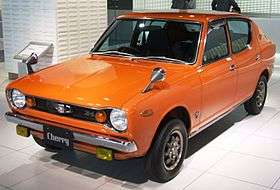 | |
| Overview | |
| Manufacturer | Nissan |
| Production | 1970–1986 |
| Assembly | Oppama Plant, Yokosuka, Kanagawa, Japan |
| Body and chassis | |
| Class | Supermini |
| Layout | Front-engine, front-wheel-drive |
| Chronology | |
| Successor |
Nissan Pulsar (Europe) Nissan March/Micra (Japan) |
The Datsun Cherry (チェリー), known later as the Nissan Cherry, was a series of small cars which formed Nissan's first front-wheel drive supermini model line.
The Cherry featured the front-engine, front-wheel-drive layout. The Cherry line includes the E10 and F10. Nissan's direct successor was the Nissan March/Micra. Although the third generation of this platform was renamed March/Micra, the "Cherry" name proved popular in Europe, so it was transferred to the larger Nissan Pulsar line for Europe.
In Japan, the Cherry was exclusive to Nissan Cherry store locations.
Background
Originally, before combining with Nissan Motors, the Prince Motor Company plan of development was to mass-produce a front-engine, front-wheel drive car, but after the Prince and Nissan merger of 1966, the Cherry was released in 1970 as Nissan's first front-wheel drive car. In Asian markets there was also a "Cherry Cab" cabover truck model (C20), which was closely related to the Nissan Sunny—it was also marketed as the "Sunny Cab".
First generation (E10; 1970–1977)
| First generation (E10) | |
|---|---|
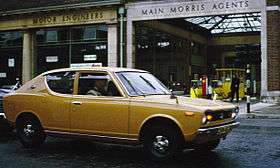 Datsun 100A Cherry 2-door 1972 (European contemporary nomenclature) | |
| Overview | |
| Also called |
Datsun 1000 Datsun 100A Datsun 120A |
| Production | 1970–1977 |
| Body and chassis | |
| Body style |
2-door sedan 4-door sedan 3-door hatchback 2-door coupé |
| Powertrain | |
| Engine |
988cc A10 I4 1.2L A12 I4 |
| Transmission |
4-speed manual all-synchromesh |
| Dimensions | |
| Wheelbase | 2,337 mm (92 in) |
| Length | 3,607 mm (142 in) |
| Width | 1,473 mm (58 in) |
| Height | 1,380 mm (54 in) |
| Curb weight | 670 kg (1,477 lb) |
The E10 generation featured four-wheel independent suspension.
The E10 was fitted with two types of inline four-cylinder Nissan A-series OHV engines:
- 988 cc A10
- 1171 cc A12
The Japanese domestic market Cherry X-1 model featured twin-carburetted A12T engine with dual-sidedraft Hitachi carburettors.
In Europe, E10 was called Datsun 100A (the Datsun brand being used in place of Nissan in the European market at that time) (with A10 engine) or Datsun 120A (A12, but this engine was only available with the coupé body style, also a semi automatic version of the ordinary car available in 1978). Reportedly, market names of Cherry and Datsun 1000 were also used, however the Datsun 1000 name was associated with the early Nissan Sunny and Nissan Bluebird. The Cherry was introduced in Japan at a specially established dealership sales channel called Nissan Cherry Shop, whereas the Sunny was sold at Nissan Satio Shop, and the Bluebird was sold at the Nissan Bluebird Shop. As the Cherry F-II successor flagged in the market, the somewhat smaller E10 Cherry continued to be sold up until 1977 in many places.[1]
With the launch of the Cherry in 1971, Datsun's prominence in the UK market grew. In the early 1970s, as the British auto-industry faltered, Datsun led the charge of Japanese auto-manufacturers rapidly gaining market share in the UK. Britain's Motor magazine polled readers about their cars, including, in February 1973, those who owned E10 Cherrys. The question given greatest prominence was the final one which asked whether or not respondents would buy another car of the same model: 76 percent of Cherry owning respondents answered "yes", which was the top score for this question achieved by any model to date, and beat even the 66 percent "yes" score given by owners of the previous leader, the Volkswagen Beetle, at the time well known in the UK for its owners' brand loyalty.[2]
Timeline
- 1970 October: E10 goes on sale in Japan. At the beginning were setting only of four-door sedans and two-door sedans.
- With 1970: 17th Tokyo motor show, exhibiting the concept car "270X" which designates the Cherry as the base.
- 1971 end of September: coupé version added
- 1972 March: three-door van version added
- Cherry coupé debuts in 1972 April race Japan. As a Nissan works entry, it participated also in other domestic Japan races.
- 1972 June: minor model change
- 1973 March: debut of Cherry coupé 1200X-1 R with "fender flares"
- 1973: Revised model with updated grill, rear lights and hubcaps released
- 1976: Acropolis Rally privateer entry
- 1977: E10 production ceases
Second generation (F10; 1974–1978)
| Second generation (F10) | |
|---|---|
 | |
| Overview | |
| Also called |
Datsun F-II Datsun F10 Datsun 100A F-II Datsun 120A F-II |
| Production | 1974–1978 |
| Body and chassis | |
| Body style |
2-door sedan 4-door sedan 3-door station wagon 2-door coupé |
| Powertrain | |
| Engine | |
| Dimensions | |
| Wheelbase | 2,395 mm (94 in) |
| Length | 3,825 mm (151 in) |
| Width | 1,500 mm (59 in) |
| Height | 1,375 mm (54 in) |
| Curb weight | 755 kg (1,664 lb) |
The second-generation Cherry was known as F-II in Japan and "Datsun F10" in North America. It was Nissan's first front-wheel-drive model to be sold in North America. Four-wheel independent suspension continued to be used. Sales of the F-II were generally disappointing,[1] and the "Cherry" nameplate was retired in Japan after this generation.
The F10 was fitted with three types of inline four-cylinder Nissan A-series OHV engines:
- 988 cc A10
- 1171 cc A12
- 1397 cc A14
A two-pedal type semi-automatic transmission was offered called the "Sportmatic", which used a torque converter obviating the need for a clutch.
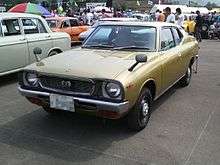
In Europe, F10 was known as Datsun 100A F-II (with A10 engine) or 120A F-II (with A12 engine). The A12 powered 120A F-II was the most common model.
In New Zealand the 100A 4-door sedan (1.0L A10 motor) was assembled from CKD kits as a price leader for the Datsun range – due to the choice of engine, it was the smallest engined car assembled in New Zealand, the engine (988 cc) being smaller than the Mini's 998 cc unit. Production continued well after the N10 model replaced it overseas, eventually being discontinued in late 1980, with the N10 5-door hatchback replacing it in 1981.
In USA, only the coupe and wagon were offered, and only with the 1.4 litre engine. In Canada, the two-door sedan was also available.
Timeline
- 1974 September: Sale started in Japan. Body styles included 2 and 4 door sedans, a coupe, and a 3-door wagon.
- 1976 Coupe introduced in UK
- 1977 Hatchback introduced in UK
- 1978: Swedish Rally privateer entry
- In May 1978 Nissan Pulsar (N10 type) appeared as a successor model to the Cherry, originally only as a four-door. The four-door Cherry F-II was discontinued, with the two-door and coupé following the corresponding additions to the Pulsar range in September 1978. At this time the Cherry name was discontinued on the Japan home market.
Third generation (N10; 1978–1982)
| Third generation (N10) | |
|---|---|
 | |
| Overview | |
| Production | 1978–1982 |
| Body and chassis | |
| Related |
Nissan Sunny Nissan Vanette |
The N10 model Pulsar was introduced to Japan in May 1978, with European sales beginning in March 1979. While known as the Nissan Pulsar in Japan, it was called Cherry in Europe and many other export markets. The body styling was more boxy, and influenced by designs coming out of Europe at that time. It came at a time when small hatchbacks were enjoying rising sales across Europe, with the Ford Fiesta, Volkswagen Polo, Renault 5 and Fiat 127 being particularly popular, along with the General Motors product which was known in Britain as the Vauxhall Chevette and on the continent as the Opel Kadett City. It continued to sell well in Britain, and the most popular foreign car there in 1981.
Engine choices were carried over from the previous model, consisting of Nissan's A-Series motor in 1.0 L, 1.2 L and 1.4 L forms. At some point, the A12 was replaced by the marginally larger A12A in export markets as well. Production of the N10 series ceased in mid-1982, to be replaced by larger N12 Cherry/Pulsar.
Fourth generation (N12; 1982–1986)
| Fourth generation (N12) | |
|---|---|
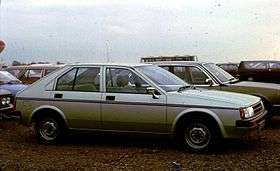 | |
| Overview | |
| Also called |
Nissan Cherry Europe Nissan Pulsar Milano Nissan Langley Nissan Liberta Villa Alfa Romeo Arna Holden Astra (LB/LC) |
| Production | 1982–1986 |
| Body and chassis | |
| Body style |
3-door hatchback 4-door sedan 5-door hatchback |
| Powertrain | |
| Engine |
988cc I4 1270cc I4 1488cc I4 1186cc Flat-4 1350cc Flat-4 1490cc Flat-4 |
.jpg)
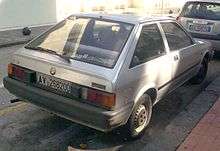
The Cherry name was still used in Europe on the model N12, an angular, three or five door hatchback design. In Europe the Cherry was sold with 988cc 50PS, 1270cc 60PS or 1488cc 69PS petrol engines. Later a high performance turbo version of the 1488cc Cherry became available. It was larger than earlier versions of the Cherry, with the new Micra taking its place in the supermini sector on its launch in 1983, leaving the Cherry to compete in Europe against the new-popular hatchback designs like the Ford Escort and Volkswagen Golf, while the Sunny gave buyers a traditional saloon and estate option.
A derivative of Cherry N12 was also built by Alfa Romeo at Pratola Serra, near Naples, Italy. The Alfa-built version was badged as either the Nissan Cherry Europe or the Alfa Arna in Europe (depending on the dealer supplying it), and as the Nissan Pulsar Milano in Japan, and is distinguishable by slightly different rear light clusters and other minor changes. Under the skin it used Alfa Romeo Alfasud-based components including the engine, transmission, and front suspension. Rear suspension and body panels came from Japan. Both Italian- and Japanese-built versions were available in European markets, but the Italian version helped to overcome strict import quotas imposed on Japanese cars at the time. Arna was an acronym meaning Alfa Romeo Nissan Autoveicoli. The Arna did not sell well and the partnership was not continued after the car's demise in 1986.
After the end of Cherry production, the Sunny was Nissan's only offering of this size in Europe, with the range launched in the autumn of 1986 including a hatchback as well as a saloon and the estate model carried over from the previous Sunny range. In America only the notchback coupe ("Pulsar NX") was offered for most of the N12's run although the three- and five-doors were sold for model year 1983 only.
Replacement by Nissan Sunny
In most export markets, the Nissan Sunny name replaced the Cherry starting with the N13 Pulsar model. In certain markets such as Greece, however, the N13 Pulsar retained the "Cherry" nameplate.[3]
In Japan and some Asian markets, the Pulsar name was used until N15 model. See the Pulsar entry for more information.
References
- 1 2 de Jong, Nico (1979-03-24). "Test: Datsun Cherry 1200 GL". Autovisie (in Dutch). Amersfoort, Netherlands: Arnold van der Wees. 24 (6): 21.
- ↑ Bulmer, Charles, ed. (3 February 1973). "On the road". Motor: 30.
- ↑ Mastrostefano, Raffaele, ed. (1990). Quattroruote: Tutte le Auto del Mondo 1990 (in Italian). Milano: Editoriale Domus S.p.A. p. 599.